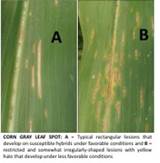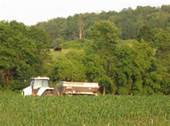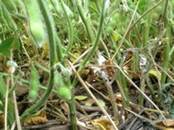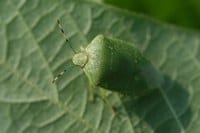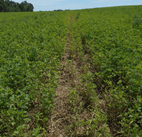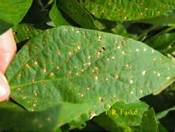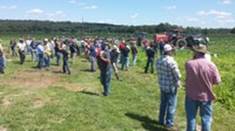Good afternoon,
Have you been to a field day lately? This is the time of year for several field days, so take advantage of the nice cool weather to attend a program that may be of interest to you. If you are still thinking about getting your fertilizer certification done this summer and are willing to travel, there will be a 3-hour Fertilizer Applicator Certification Training field day in Brookville on Thursday, August 27 featuring beef manure storage and lagoon as well as field demonstrations. See the attached flyer for further details. There is good news to report with the Western Bean Cutworm traps. Although there has been some damage to corn in Ohio recently from this pest, once again I did not catch any adult moths in our Hardin County traps this past week.
A field day that is closer to home is the Hardin County Field Day on September 18. I have already mentioned this in a previous version of this newsletter, but have included an attached Save-the-Date postcard to remind you of our upcoming event planned with the Hardin Soil and Water Conservation District, Natural Resources Conservation Service, The Nature Conservancy, John Deere, and OSU Extension. And of course, the granddaddy of all field days, the Farm Science Review will be held September 22-24 at the Molly Caren Agricultural Center in London. Our office has pre-sale tickets available now for this event at the cost $7.00 per person.
Now is the time to think about planting fall cover crops if you haven’t already considered them. Putnam County OSU Extension Educator Jim Hoorman wrote an excellent article that I sent out to local media this past week. If you haven’t already read it, I would encourage you to do so as I have attached it to this email. While we are on the subject of cover crops, there will be a Soil Health workshop series this fall and winter in Champaign County. See the attached flyer for more information and registration details about this workshop which will feature a tour of Brookside Labs as part of this series.
The Logan County Master Gardeners are hosting an Edible Landscaping workshop on Saturday, September 12 in Bellefontaine. Topics will include Edible Ornamentals: the Marriage Between Use and Beauty, Vegetable Gardening into Fall & Winter, and Preservation of Vegetables & Herbs. See the attached brochure for more details and registration information for this program being held in our backyard.
Friday and Saturday, August 28-29 will be the Ohio Master Gardener Volunteers Conference at Maumee Bay State Park. Our Hardin County Master Gardeners are up for several statewide awards. Other local events in the next week include an International Sheep Tour planning meeting tonight at the Extension office starting with a meal at 6:00 pm, followed by the meeting. A Hardin County Fair Work Day will be on Saturday, August 29 at the fairgrounds. Show up at 8:30 in the morning to help prepare the buildings for this year’s fair. There will be an Ag Hall of Fame committee meeting on Monday, August 31 at the Extension office, starting at 6:30 pm.
The Hardin County Extension Office will be closed during this year’s fair. If you need to contact any of our staff, call the fair office at (419) 675-2396 and they will put you in contact with us. Also, remember that we have Hardin County Fair season tickets for sale in our office through Friday, September 4 for the price of $20. See below for agronomy related articles that you may be interested in reading.
Mark
From Wet Weather to Dry Weather… – Laura Lindsey
Most areas in Ohio experienced above average rainfall during soybean vegetative stages. With wet weather, soybeans tend to have reduced tap root growth and increased lateral root growth near the soil surface. This is a problem when the weather turns dry…Dry areas in Ohio are reporting drought stress conditions on soybean such as soybean leaves flipping upside down. August rainfall is very important as soybean seeds begin to fill. (Soybean yield is determined by the number of plants, number of pods per plant, number of seeds per pod, and seed size). On average, there are 2,500 individual soybean seeds per pound. Soybean seeds produced during drought conditions and at high temperatures tend to be smaller than seeds produced under normal conditions.
This Might end up being a Low Foliar Disease Year in Corn – Pierce Paul
Early development of gray leaf spot (GLS) and northern corn leaf blight (NCLB) had us all concerned about the potential for major epidemics of these diseases in 2015. However, conditions have since been warm and dry across most of the state, drastically reducing the spread of these and other foliar diseases. In fact, lesions of GLS and eye spot from early outbreaks can still be found on leaves below the ear in some fields, but in most cases they are of restricted development and the disease has not spread to the upper leaves. Even NCLB, a disease known to affect the upper leaves during the last two months of the season, appears to be low in 2015. To read more about corn foliar diseases in 2015, go to http://corn.osu.edu/newsletters/2015/2015-27/this-might-end-up-being-a-low-foliar-disease-year-in-corn.
Scout Fields Now for Palmer Amaranth – Mark Loux
The frequency of Palmer amaranth infestations in Ohio has been holding relatively steady again into this year. We have mostly an isolated field or patch in about 10 counties, with the exception of two small epicenters of Palmer amaranth – far southern Scioto County and an area along the Madison-Fayette County line north of Jeffersonville. Several new infestations of Palmer amaranth in soybeans have been reported over the past several weeks though. It was also found in a first-year hayfield, where cutting and competition from the alfalfa/grass stand will likely keep it under control in coming years. None of these appear to have produced viable seed yet. To read more about scouting for Palmer amaranth, go to http://corn.osu.edu/newsletters/2015/2015-27/scout-fields-now-for-palmer-amaranth.
2015 Ohio Wheat Performance Test Available Online – Laura Lindsey, Rich Minyo
A pdf of the 2015 Ohio Wheat Performance Test can be found at the Soybean and Small Grain website at: http://stepupsoy.osu.edu/node/35. A sortable version of the Ohio Wheat Performance Test can be found at: http://www.oardc.ohio-state.edu/wheattrials/regions.asp?year=2015#single. Test results are for 78 soft red winter wheat varieties grown at five Ohio locations (Wood, Crawford, Wayne, Darke, and Pickaway County). Variety selection should be based on disease resistance, average yield across test sites and years, winter hardiness, test weight, and standability. Overall, grain test weight averaged 56.3 lb/bu (compared to an average test weight of 58.8 lb/bu in 2014). Grain yield averaged between 77 and 92 bu/acre at the five locations in the test. Lower than normal test weight and grain yield may be attributed to wet weather in June and July and delayed harvest.
Don’t Press the Panic Button on Soybean Aphid Yet – Andy Michel
As predicted, we have begun to see soybean aphids move into soybean fields over the past few weeks. Coincidentally, this is the 3rd year in a row that we have seen aphids move in relatively late in the growing season. Hopefully, most of our soybean are starting to mature and reaching the R6 stage, but there are some that still have a way to go due to delayed spring maturity. By now we all should be familiar with the soybean aphid threshold of a rising population of 250 aphids per plant. But keep in mind that this number is the action threshold, it is not the economic injury level (EIL) at which soybean aphid causes yield loss. Yield loss occurs when aphids reach 500-600 aphids per plant. If you soybeans are at R4 and below, then continue to use the 250 threshold. However, the threshold does not apply to beans at R6 and later. The thresholds at these growth stages increase to over 1,000 aphids per plant. For more information about soybean aphid thresholds, go to http://corn.osu.edu/newsletters/2015/2015-26/don2019t-press-the-panic-button-on-soybean-aphid-yet.
Mark A. Badertscher
Agriculture and Natural Resources Educator
OSU Extension Hardin County
1021 W. Lima Street, Suite 103, Kenton, OH 43326
419-674-2297 Office

